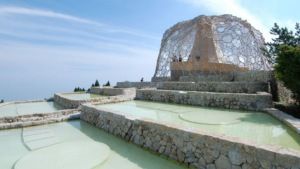News
Louisiana Channel: Supplying culture to the world
This article is more than 7 years old.
How Denmark’s most beloved art museum is casting its eye beyond the country’s borders and finding a massive audience

Marina Abramović in action (all photos: Louisiana Channel)
A tiny Danish video channel, based in the village of Humlebæk 35 km north of Copenhagen, is attracting large audiences worldwide thanks to its eclectic mix of art, music, literature and culture.
Each day 12,000 people view the Louisiana Channel’s videos, and that number keeps rising. The Louisiana Channel is a non-profit platform that supplies culture to the world through weekly curated videos about different types of art and culture.
To find out how the channel has achieved this success, CPH POST spoke to Christian Lund, a co-editor at the Louisiana Channel. As co-editor, Lund researches ideas and artists, conducts interviews and edits footage to produce videos for the site.
A global impact
“Recently we experienced a four-minute video with Marina Abramović and Ulay presenting their collaborative performance ’Imponderabilia’ – within three months it has become our most viewed video with more than 850,000 views,” revealed Lund.
The channel has certainly made a global impact. The more than 500 videos have been viewed in almost every country in the world.
“It is very rewarding to publish videos in Humlebæk, Denmark and experience that people for instance in Berlin, London, Toronto, New York, Madrid, Rome, Buenos Aires, São Paulo, Los Angeles and Paris watch and comment [on] our videos in an appreciative way. Using today’s digital technology, we see ourselves as a new media provider – part TV station, part newspaper” says Lund.
Recipe for success
The channel’s reach extends beyond the museum’s own events and exhibitions.
A unique aspect of the Louisiana Channel is that since its founding in 2012 it has worked independently of the Louisiana Museum of Modern Art, meaning the videos on the site do not relate to the museum’s exhibitions.
Instead, the channel interviews artists visiting the museum as well as artists who do not make the trek to Humlebæk.
“You can’t tell beforehand what will be most popular. We have one hour-long videos in our top ten of most viewed videos,” said Lund.
The Louisiana Channel features videos that vary in both style and length. The style of video depends on the footage their team is able to capture with the artists, writers, and musicians they choose to spotlight.
“Their diversity is our aim, but of course the videos are made according to the people – us – making them. So you can probably sense that we are a part of a Danish tradition of ‘public service’ journalism and in addition [to] Louisiana’s tradition of presenting high quality content to a great number of museum guests – I guess that’s our recipe,” said Lund.
New website in the works
The Louisiana Channel team, which only consists of six employees in addition to freelance photographers, aims to make their video portraits eternal, so that they are just as relevant today as they are decades from now.
“We often experience that our videos are discovered anew, giving them new lives in the ever-present moment that is called the internet,” explained Lund.
Right now the Louisiana Channel team is in the process of launching a new website.
The new site will move away from the archive-like style currently used and transition the channel into a more interactive experience. The new site will have a different design aimed to create more of a community while supporting the growing number of viewers. The site is expected to launch within the next couple months.
Widely spread across platforms
In addition to launching a new site, the Louisiana Channel team also focuses on using a mix of media platforms to engage with its visitors.
“We engage with our viewers on different platforms such as our site, Vimeo and YouTube, but we use all social media platforms to communicate with and reach our viewers. Especially on YouTube we have seen a huge growth in subscribers to our channel, where 37,000 people get a notification twice a week when we publish a new video. On Facebook 60,000 people follow our updates and videos,” enthused Lund.
In order to achieve this global reach, the Louisiana Channel collaborates with major websites across the world. One such collaboration was with ArchDaily, an American site that is one of the world’s biggest sites on architecture.
Additionally, funding from Nordea-Fonder, Dreyers Fond, and Louisiana Fonden has helped the Louisiana Channel realise its ambition.











































